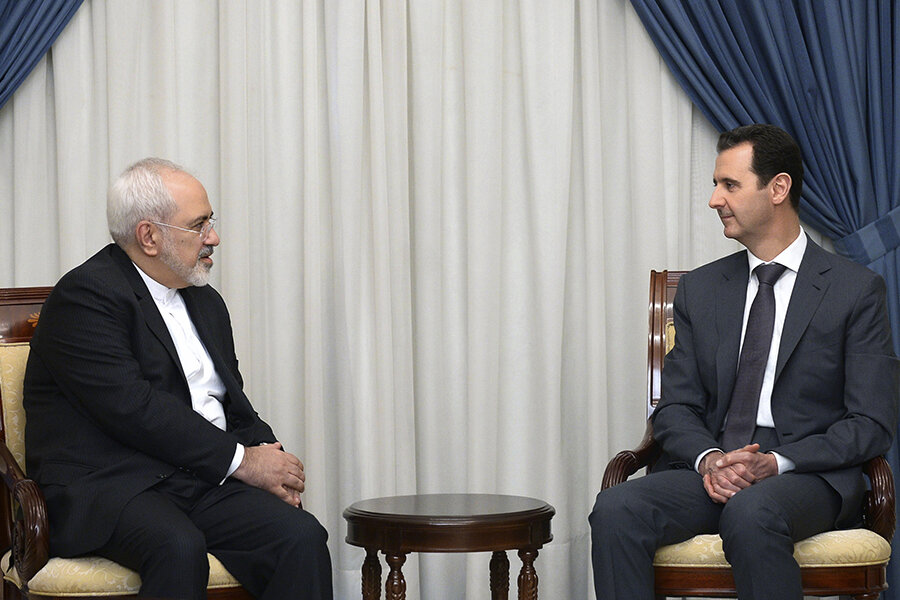Deadly attacks in Syria as Iranian foreign minister visits
Loading...
| Damascus, Syria
Iran's foreign minister who negotiated his country's nuclear deal with world powers discussed ways of ending Syria's civil war with President Bashar Assad in Damascus on Wednesday, as attacks surged around the Syrian capital, killing at least 36 people and wounding dozens.
Stepped-up rebel shelling and government airstrikes came just a few hours before Mohammad Javad Zarif arrived in Damascus, where he discussed a four-point proposal Iran wants to offer to the United Nations as a way out of Syria's grinding conflict.
That plan, according to a Lebanese politician familiar with the proposal, includes a cease-fire and a power-sharing government that would keep Assad in the picture, at least for now, pending internationally supervised elections. The politician, who spoke on condition of anonymity because he was not authorized to divulge details of the plan, said it shows the Iranians were "not ready" to withdraw their support for Assad.
Syrian state-run TV quoted Zarif as saying after talks with Assad that their discussion focused on ways of ending the Syrian crisis.
"It is time for the other players and our neighbors to take note of reality, listen to the demands of the Syrian people and work for combatting extremism and terrorism," Zarif said, referring to Gulf Arab countries that back Syrian rebels.
According to Syria's state news agency, SANA, Zarif stressed that any solution for the crisis should be "far from any foreign intervention and in a way that preserves the country's territorial unity" and independence. He also underlined Iran's determination to continue supporting Syria.
But the day's surge in violence underscored the improbability of efforts to bring about a truce anytime soon in a conflict that has killed more than 250,000 people, displaced half the country's population since March 2011 and allowed the Islamic State group to flourish. Assad has lost control over more than half the country by some estimates — much of it now ruled by warlords and militias.
Still, Tehran's landmark nuclear deal with world powers is widely seen as providing an opportunity for achieving some kind of breakthrough on Syria.
The deal has opened diplomatic channels between Saudi Arabia and Assad's Iran-backed government, although the Saudi foreign minister, Adel Al-Jubeir, denied on Tuesday his country was wavering in its position that Assad should have no future role in Syria.
The rebel shelling, which apparently meant to send a message that Zarif was not welcome in Syria, began around the morning rush hour in Damascus. More than 50 shells struck the city, including in the upper-class neighborhoods of Abu Rummaneh, Baramkeh and Qasaa.
Five people were killed and dozens were wounded, according to Syrian state TV and the Britain-based Syrian Observatory for Human Rights.
"We hid for two hours in the bathroom," said a resident over the telephone from Qasaa, who spoke on condition of anonymity for fear of reprisals. "My children woke up terrified. Our windows were shattered and so was my car's windshield."
Shortly afterward, government warplanes unleashed a wave of airstrikes on several rebel-held suburbs of the capital. The Local Coordination Committees, an activist group, said the air raids on Hamouriyeh, Saqba, Kfar Batna, Douma and Arbeen killed 35 people and wounded dozens. The Observatory said the airstrikes killed at least 31 and wounded more than 120. Disparate accounts
Videos uploaded on the Internet by activists showed massive destruction in Saqba and a number of casualties apparently being led away from a blood-stained street strewn with debris. Another video from Douma shows civil defense workers carrying victims on stretchers.
Iran is one of Assad's strongest supporters and the Iranian-backed Lebanese militant group Hezbollah has sent thousands of fighters to Syria to back government forces.
Assad's enormous territorial losses in the past months may be pushing him to explore diplomatic options to resolve the crisis. But he is unlikely to fully step aside, and if anything, he may be more inclined to cling to power in the hope that an Iran freed of economic sanctions would support him all the more with funds for his battered army.
Also, regional and international players, including Russia and the United States, may be more inclined to compromise on ways to end the conflict, having become more convinced that fighting the Islamic State group overtakes the ouster of Assad as a priority.
Analysts say there is an intense among different power centers in Iran on what to do about Syria.
"While Iranian officials have always stated they are not wedded to individuals in Syria, and that their interest lies in preventing regime implosion, they still don't see a way of preserving the regime institutional infrastructure without Assad," said Randa Slim, a director at the Washington-based Middle East Institute.
During a stop in Beirut before coming to Damascus, Zarif did not mention the Syrian war. He said there is "a new opportunity" for all the countries in the region to cooperate against "regional enemies: the Zionist entity and extremism, terrorism and sectarianism."
"We are ready to extend our hand for cooperation with all the neighbors and to exchange ideas for joint work against terrorism," he said after meeting with Lebanese Foreign Minister Gibran Bassil.
Hezbollah's leader Sheikh Hassan Nasrallah also met with Zarif and the militant group's Al-Manar television said they discussed attempts "to find solutions in more than one country."
Al-Manar and Syrian activists also said that a 48-hour cease-fire between Hezbollah fighters and rebel and militant groups started Wednesday morning in Zabadani, a Syrian town near the Lebanese border, as well as in Foua and Kfarya, two Shiite villages in northern Syria's Idlib province.
Hezbollah and Syrian troops have been trying to fully capture the one-time rebel stronghold of Zabadani for more than a month. A coalition of rebel groups retaliated by attacking Foua and Kfarya. A large number of civilians are trapped there by the fighting.







